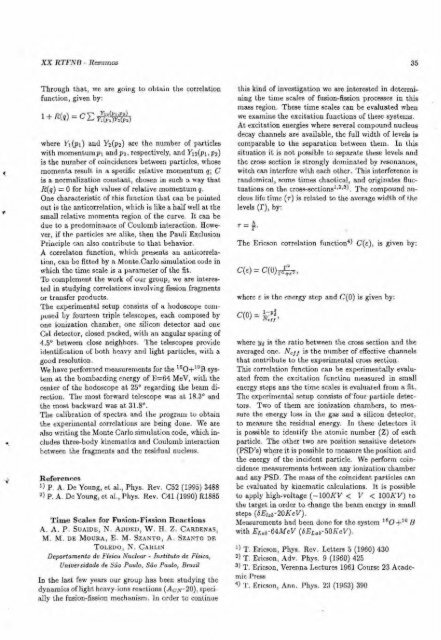REINA() DE TRABALHO SOBRE FiSICA NUCLEAR NO BRASIL
REINA() DE TRABALHO SOBRE FiSICA NUCLEAR NO BRASIL
REINA() DE TRABALHO SOBRE FiSICA NUCLEAR NO BRASIL
You also want an ePaper? Increase the reach of your titles
YUMPU automatically turns print PDFs into web optimized ePapers that Google loves.
XX RTI'Nfi .Tiesurnos 35<br />
Through that, we are going to obtain the correlation<br />
function, given by:<br />
1+ = CEF'T-6', L(Wg5<br />
where Y1 (p1) and Y2(p2) are the number of particles<br />
with momentum/4 and p2, respectively, and Y12(Pi pz)<br />
is the number of coincidences between particles, whose<br />
momenta result in a specific relative momentum q; C<br />
is a normalization constant, chosen in such a way that<br />
R(q) = 0 for high values of relative momentum q.<br />
One characteristic of this function that can be pointed<br />
out is the anticorrelation, which is like a half well at the<br />
small relative momenta region of the curve. It can be<br />
due to a predominance of Coulomb interaction. However,<br />
if the particles are alike, then the Pauli Exclusion<br />
Principle can also contribute to that behavior.<br />
A correlaton function, which presents an anticorrelation,<br />
can be fitted by a Monte. Carlo simulation code in<br />
which the time scale is a parameter of the fit.<br />
To complement the work of our group, we are interested<br />
in studying correlations involving fission fragments<br />
or transfer products.<br />
The experimental setup consists of a hodoscope composed<br />
by fourteen triple telescopes, each composed by<br />
one ionization chamber, one silicon detector and one<br />
Csl detector, closed packed, with an angular spacing of<br />
4.5° between close neighbors. The telescopes provide<br />
identification of both heavy and light particles, with a<br />
good resolution.<br />
We have performed measurements for the 160+ 1 °B system<br />
at the bombarding energy of E=64 MeV, with the<br />
center of the hodoscope at 25° regarding the beam direction.<br />
The most forward telescope was at 18.3° and<br />
the most backward was at 31.8°.<br />
The calibration of spectra and the program to obtain<br />
the experimental correlations are being done. We are<br />
also writing the Monte Carlo simulation code, which inchides<br />
three-body kinematics and Coulomb interaction<br />
between the fragments and the residual nucleus.<br />
References<br />
i) P. A. De Young, at al., Phys. Rev. C52 (1995) 3488<br />
2) P. A. De Young, et al., Phys. Rev. C41 (1990) R1885<br />
Time Scales for Fusion-Fission Reactions<br />
A. A. P. SUAI<strong>DE</strong>, N. Appel), W. H. Z. CAR<strong>DE</strong>NAS,<br />
M. M. <strong>DE</strong> MOURA, E. M. SZANTO, A. SZANTO <strong>DE</strong><br />
TOLEDO, N. CARLIN<br />
Departamento dc Fisica Nuclear - Institut° do Fisica,<br />
Universidade de Silo Paulo, Silo Paulo, Brazil<br />
In the last few years our group has been studying the<br />
dynamics of light heavy-ions reactions (Ac,v- 20), speci-<br />
ally the fusion-fission mechanism. in order to continue<br />
this kind of investigation we are interested in determining<br />
the time scales of fusion-fission processes in this<br />
mass region. These time scales can he evaluated when<br />
we examine the excitation functions of these systems.<br />
At excitation energies where several compound nucleus<br />
decay channels are available, the full width of levels is<br />
comparable to the separation between them. In this<br />
situation it is not possible to separate these levels and<br />
the cross section is strongly dominated by resonances,<br />
witch can interfere with each other. This interference is<br />
randomical, some times chaotical, and originates fluctuations<br />
on the cross-sections 1 :2,3). The compound nucleus<br />
life time (r) is related to the average width of the<br />
levels (r), by:<br />
h<br />
The Ericson correlation function 4) C(e), is given by:<br />
C(e) =<br />
where c is the energy step and C(0) is given by:<br />
C(0) =<br />
where yd is the ratio between the cross section and the<br />
averaged one. Nol is the number of effective channels<br />
that contribute to the experimental cross section.<br />
This correlation function can be experimentally evaluated<br />
from the excitation function measured in small<br />
energy steps ans the time scales is evaluated from a fit.<br />
The experimental setup consists of'four particle detectors.<br />
Two of them are ionization chambers, to measure<br />
the energy loss in the gas and a silicon detector,<br />
to measure the residual energy. In these detectors it<br />
is possible to identify the atomic number (Z) of each<br />
particle. The other two are position sensitive detetors<br />
(PSD's) where it is possible to measure the position and<br />
the energy of the incident particle. We perform coincidence<br />
measurements between any ionization chamber<br />
and any PSD. The mass of the coincident particles can<br />
be evaluated by kinematic calculations. It is possible<br />
to apply high-voltage (-100KV < V < 100KV) to<br />
the target in order to change the beam energy in small<br />
steps (5.Ei,b- 20Ke V).<br />
Measurements had been done for the system 18D-1- 10 fi<br />
with Ez0,-64MeV (5.E.r,,b-50KeV).<br />
i) T. Ericson, Phys. Rev. Letters 5 (1960) 430<br />
2)T. Ericson, Adv. Phys. 9 (1960) 425<br />
3)T. Ericson, Vererma Lectures 1961 Course 23 Academic<br />
Press<br />
4)T. Ericson, Ann. Phys. 23 (1963) 390
















